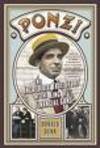Arthur Fergson & Charles Ponzi Scam Artists
Most of us are familiar with the famous "Ponzi scheme" a scam worked by Charles Ponzi in the 1900’s. Ponzi was an Italian immigrant who became famous for his swindles after immigrating in  1903. Standing only 5′ 2" tall, Ponzi had a gift of gab, enormous self confidence and a charming manner. After serving a prison term in Canada for forging checks he came back to the United States where he served time again for involvement in an illegal immigrant scheme.
1903. Standing only 5′ 2" tall, Ponzi had a gift of gab, enormous self confidence and a charming manner. After serving a prison term in Canada for forging checks he came back to the United States where he served time again for involvement in an illegal immigrant scheme.
Then Ponzi hit on a pyramid scheme in which he would promise as much as a 50% return up to doubling money within 45 days. He claimed the process involved investments in postal coupons used to send money back to the old country. He would give promissory notes which he paid off with a profit to the earlier investors. But, what he was actually doing was using the new money being invested to pay the old debts owed in a classic pyramid scheme. Obviously such a system can’t go on forever, but before the pyramid collapsed, Ponzi had collected over $9.5 million dollars from some 10,000 investors. After serving time in prison for the scheme he died in a charity ward in Rio de Janeiro in 1949.
While I had read about Ponzi, I wasn’t aware of Arthur Ferguson. In Thomas Ayres book That’s Not in My American History Book he describes the activity of Ferguson, a Scottish scam artist in the 1920’s. His skill was the ability to talk people into buying national landmarks in Great Brittan and the United States. In London, he successfully sold Nelson’s column in Trafalgar Square to a buyer who paid him 6000 pounds for it. His story was that it was being sold to reduce the national and that he was in charge of this top secret sale. After that, he had a story which resulted in a buyer paying him a 1,000 pound down payment to buy Big Ben. Another enthusiastic buyer gave him a 2,000 pound down payment to buy Buckingham Palace. He had a gift of gab and always had a plausible story. He claimed to be the government official charged with the obligation of making the sale for the British government. Most people were reluctant to even report the crime for fear of looking foolish. After selling other landmarks he decided it was time to leave the U.K.
After immigrating to the United States in 1925 he sold the White House to a wealthy rancher on an installment plan for yearly payments of $100,000 collecting the first payment in advance. His story was that Congress planned to build a new White House at a nearby location and need to sell the old one. One day he was admiring the Statue of Liberty when he confided to a visiting Australian that it was sad that it had to be sold because New York was widening the harbor and needed to get rid of it. Ferguson had always moved quickly in these schemes, but this time he took too long to close the deal because the Australian was having trouble raising money from friends back home and finally became suspicious. He went to the police and Ferguson wen to jail. He died in Los Angeles in 1938. It is always surprising how gullible people can be, but then look at all the people who voted for George Bush and Dick Cheney.
